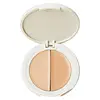What's inside
What's inside
 Key Ingredients
Key Ingredients

 Benefits
Benefits

 Concerns
Concerns

 Ingredients Side-by-side
Ingredients Side-by-side

Silica
AbrasiveSimmondsia Chinensis Seed Oil
EmollientGlycerin
HumectantButylene Glycol
HumectantHelianthus Annuus Seed Oil Unsaponifiables
EmollientSqualane
Emollient1,2-Hexanediol
Skin ConditioningBrassica Oleracea Gemmifera Extract
AstringentSolanum Lycopersicum Fruit Extract
AntioxidantLecithin
EmollientSimmondsia Chinensis Leaf Extract
HumectantLeontopodium Alpinum Extract
Skin ConditioningHydrogenated Lecithin
EmulsifyingPhoenix Dactylifera Seed
Skin ConditioningAscorbic Acid
AntioxidantTromethamine
BufferingDipotassium Glycyrrhizate
HumectantCeramide NP
Skin ConditioningSodium Metabisulfite
AntioxidantSodium Sulfite
PreservativeSilica, Simmondsia Chinensis Seed Oil, Glycerin, Butylene Glycol, Helianthus Annuus Seed Oil Unsaponifiables, Squalane, 1,2-Hexanediol, Brassica Oleracea Gemmifera Extract, Solanum Lycopersicum Fruit Extract, Lecithin, Simmondsia Chinensis Leaf Extract, Leontopodium Alpinum Extract, Hydrogenated Lecithin, Phoenix Dactylifera Seed, Ascorbic Acid, Tromethamine, Dipotassium Glycyrrhizate, Ceramide NP, Sodium Metabisulfite, Sodium Sulfite
Isononyl Isononanoate
EmollientOctyldodecanol
EmollientOctyldodecyl Stearoyl Stearate
EmollientKaolin
AbrasiveHydrogenated Castor Oil
EmollientSynthetic Wax
AbrasiveSilica
AbrasiveTocopheryl Acetate
AntioxidantPhenethyl Alcohol
MaskingCaprylyl Glycol
EmollientSimmondsia Chinensis Seed Oil
EmollientSilica Dimethyl Silylate
EmollientCI 77891
Cosmetic ColorantCI 77492
Cosmetic ColorantCI 77491
Cosmetic ColorantCI 77499
Cosmetic Colorant
 Reviews
Reviews

Ingredients Explained
These ingredients are found in both products.
Ingredients higher up in an ingredient list are typically present in a larger amount.
Silica, also known as silicon dioxide, is a naturally occurring mineral. It is used as a fine, spherical, and porous powder in cosmetics.
Though it has exfoliant properties, the function of silica varies depending on the product.
The unique structure of silica enhances the spreadability and adds smoothness, making it a great texture enhancer.
It is also used as an active carrier, emulsifier, and mattifier due to its ability to absorb excess oil.
In some products, tiny microneedles called spicules are made from silica or hydrolyzed sponge. When you rub them in, they lightly polish away dead skin layers and enhance the penetration of active ingredients.
Learn more about SilicaThis oil comes from the seeds of the desert shrub called Jojoba. It is more commonly known as jojoba oil, a non-comedogenic oil.
Jojoba oil does not contain fragrance and has many fatty-acids, making it a great soothing ingredient.
It also contains Vitamin E, a great moisturizing ingredient. Vitamin E is also an antioxidant and protects your skin against oxidative damage.
This ingredient humectant properties, meaning it helps draw moisture from the air. This helps keep your skin hydrated.
While jojoba has antibacterial properties, it is only able to kill some strains of bacteria.
Studies also show it helps in wound healing. In fact, Indigenous cultures have used jojoba as a moisturizer and to help treat burns for centuries.
Fun fact: Jojoba oil similar to natural human skin sebum, so it has a great effect on dry skin. It is also promising with helping to regulate sebum production.
Due to its fatty acid content, Jojoba oil may not be fungal acne safe. We recommend speaking with a professional if you have any concerns.
Learn more about Simmondsia Chinensis Seed Oil